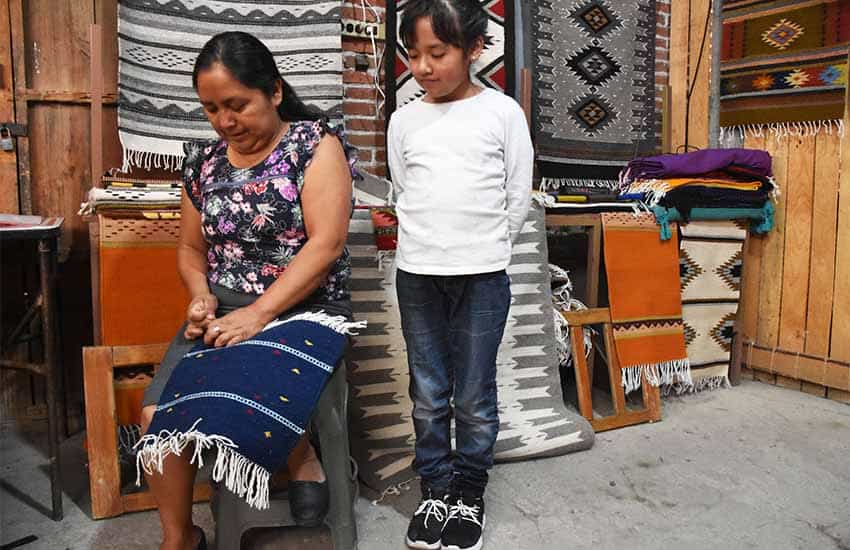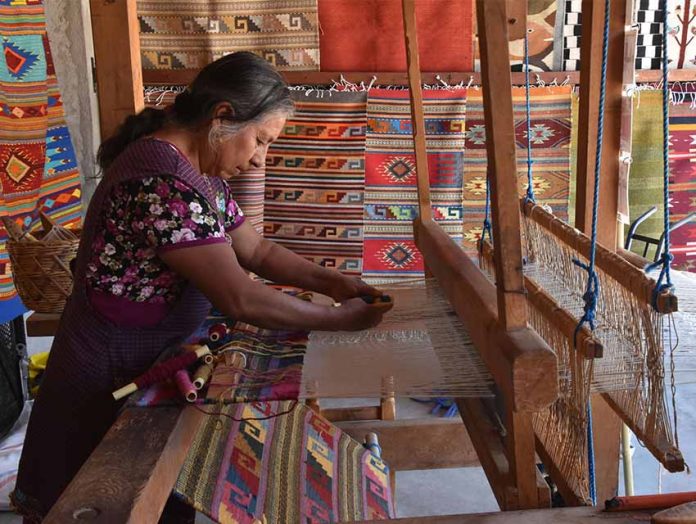Graciela Contreras Mendoza is a picture of concentration as she leans over her loom, deftly weaving different colored threads into a rug she’s making. “I made my first rug when I was ten,” she said.
She, and about 150 families in Teotitlán del Valle, a pueblo about 20 miles from the city of Oaxaca, are well known for the quality of their textiles, especially their rugs. Weaving in the pueblo dates back hundreds of years. “It is a work that we carry in our blood,” she said.
Teotitlán del Valle is a Zapotecan pueblo, but its current name is actually from Nahuatl and means “land of the gods.” Its original name was Xaquija, Zapotecan for “celestial constellation.”
Children start learning to weave here typically as young as eight or 10 years old.
“First, we learn how to comb the wool,” said Contreras. “Then we learn how to wash the wool and make the string.” Most of the wool that’s used here comes from sheep raised in other states, usually Puebla, Michoacán and Guererro.

After combing, the wool is gathered into a ball and then made into string, using a spinning wheel. It’s then dyed a wide variety of colors. The dyes are all natural and organic, said Hermelinda Bautista Bautista, who was working with her friend Marcela Cruz Lazo in their small workshop. “We use things like shells from nuts, pomegranates and cochinilla,” Bautista said.
Cochinilla, an insect that lives on nopal, an edible cactus, is collected and ground using a molcajete, a traditional kitchen implement. It yields a deep red color.
Once the various dyes are ground into a fine powder, they’re boiled. The wool is then soaked in the dyes for three days, and then it’s all boiled again, so the wool grabs the color, said Cruz. After those steps are mastered, she said, it takes about a year to learn how to weave. There’s no formal teaching.
“There are no classes,” said Contreras. “We learn by watching. It is informal, more or less. We live with our parents, and we learn from them.”
The first rugs made are simple, just straight lines.
“To make a more complicated piece takes up to two years [of training],” said Rigoberto Martínez, a weaver whose family has a store in Oaxaca, across the street from the Santo Domingo Cathedral. “The large pieces are made by experts with more ability. All one needs is ingenuity — or that is to say — one must be very intelligent to make the designs. Some designs come from books and others from imagination.”
Teotitlán del Valle was one of the first pueblos settled by the Zapotecs, probably around 1465. Ruins of a temple, whose walls are carved with intricate designs, can still be seen here. Those designs are often incorporated into the rugs.
“There are ancient designs that are part of our history,” said Contreras. “We work with Zapotecan designs that are based on the ruins in the pueblo. But we also innovate, using something modern, and these are unique. I like to innovate and create new pieces because it bores me to make always make the same thing. I always prefer change.”
While some weavers will first draw their designs on paper, Contreras doesn’t. “My drawings are in my head,” she explained.
Each family has its unique set of designs and, according to the women interviewed, men make the most complex ones.
“The men make the most complicated designs because they’re dedicated to this work,” said Cruz. “The women do not have the time because they have to take care of their homes. They must clean, cook and care for their children.”
Weaving knowledge and the designs used aren’t the only things handed down through time. “The looms that we use have been passed down from generation to generation,” said Contreras. “We only do maintenance on the ones that require it.”

Although Cruz believes that most of the pueblo’s youth have learned how to weave, she said that some have less interest in it. “The girls now make only a few [rugs] because they go to school,” she said. “Before, the women would weave from when they were little [and] they did not talk about going to school.”
Still, given that there are dozens of stores where rugs can be bought, it doesn’t appear that the craft is in danger of dying out.
The road leading into town from the main highway is lined with a number of stores, but Martínez said they’re not the best place to buy anything.
“At the entrance to Teotitlán, they sell their rugs at a very high price since they work with tourist guides.” He suggested continuing on into the pueblo, where he said rugs are sold for less.
But beautiful textiles aren’t the only attractions here. There’s a community museum, called Balaa Xtee Guech Gulal, Zapotecan for “Shadow of the Old Pueblo” or “House of the Old Pueblo.”
In addition to rooms with the expected exhibits about weaving and photographs of daily life in the pueblo, there’s an impressive collection of pre-Hispanic figures, bowls and intricately carved stones. Some of the pieces on display have Olmec designs and are thought to date to 500 B.C.
A short distance from the museum is the Preciosa Sangre de Cristo church, which was started in 1581 but wasn’t completed until 1758. The church was built on top of a Zapotecan temple, which was destroyed by the Spanish.
Several large stones with Zapotecan designs were incorporated into the exterior walls of the church. Directly behind it, there’s an archeological site where the remains of the indigenous temple can still be seen. The church’s interior contains a large number of lovely polychrome statues of saints.
The majority of residents earn their income from weaving, said Martínez. “It is better to make the textiles because sometimes in the field there is no harvest,” he said. “Textiles are more secure and we can also trade for what we need.” But most people still farm and that’s what helped them get through the pandemic. Like every city and pueblo in Mexico, Teotitlán del Valle was adversely affected by the pandemic. “There was no tourism, and we could not sell our carpets,” said Contreras. “The pueblo survived because we have agriculture.”
Teotitlán del Valle is a very traditional pueblo, one where, said Bautista, “everyone speaks Zapotecan.” In fact, she said, “We did not speak Spanish until we went to school, and we were afraid to learn it.”
Martínez is proud of his pueblo and his heritage.
“The valley of Oaxaca was Zapotecan, and they originated this type of work,” he said. “It is like a gift that our ancestors gave to us. We are lucky to be Zapotecans.”
Joseph Sorrentino, a writer, photographer and author of the book San Gregorio Atlapulco: Cosmvisiones and of Stinky Island Tales: Some Stories from an Italian-American Childhood, is a regular contributor to Mexico News Daily. More examples of his photographs and links to other articles may be found at www.sorrentinophotography.com He currently lives in Chipilo, Puebla.
